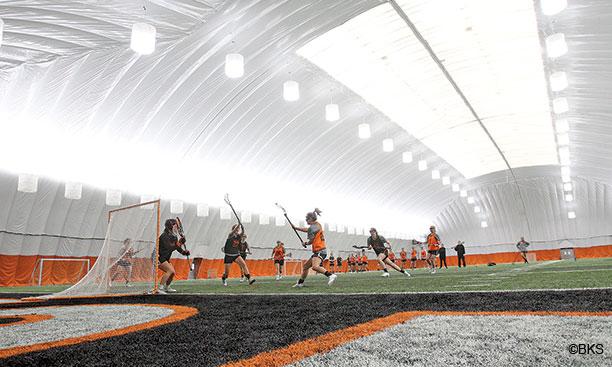
February in Princeton occasionally includes a stretch of mild, sunny days when athletes in the spring sports can draw deep breaths outdoors and look ahead to the coming season. But more often, it’s a month of challenging conditions — four weeks of frigid wind, snow, and frozen turf.
“It can be so brutal sometimes,” said Chris Sailer, who has guided the women’s lacrosse team through 32 wintry preseasons.
This February promised a warmer outlook: With the addition of a bubble at Princeton Stadium (formally an “air-supported temporary structure”), Tiger teams were able to practice indoors in a heated space that covers the length and breadth of the artificial-turf football field.
The new facility is particularly valuable for the lacrosse teams, which began formal practices Feb. 1, two and a half weeks before their opening games. “You do the majority of your teaching in February, and we need to be very efficient with our time,” said men’s lacrosse coach Matt Madalon. “The bubble allows us to maximize that practice time.”
At least 10 teams are expected to train inside the bubble, which will be installed annually from November to March. Intramurals and club teams are using the space as well. Funded by an anonymous $3.5 million gift, the bubble features a skylight in the center, LED lights, and a layer of insulation to promote energy efficiency, according to Greg Paczkowski, an associate director of athletics.
By expanding its winter athletics spaces, Princeton is following a recent trend among the Ivies. Harvard, Penn, and Columbia have bubbles as well.
Before the addition of the bubble, field sports either practiced outside or booked time at the turf space on Jadwin Gym’s lowest level, affectionately known as “the pit”; its popularity tended to be inversely proportional to the temperature outside.
The baseball and softball teams continue to have a winter home in the pit, but they also spend time in the bubble, where players have more space to stretch their throwing arms. Softball uses the space for scrimmages, with “bubble rules” in effect — fly balls that hit the ceiling are automatic outs.
Softball coach Lisa Van Ackeren said the bubble has been a positive addition, both for current athletes and visiting recruits. “It just speaks to the investment in the athletics department,” she said. “That’s the biggest thing it says to prospective athletes.”
